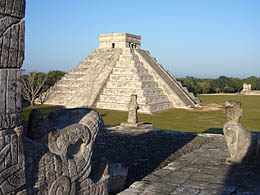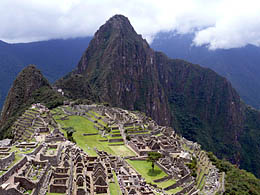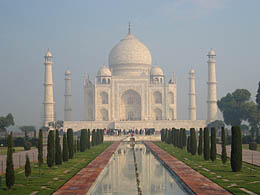
Business cards of the seven new wonders of the world
Visiting the seven new wonders of the world (listed alphabetically):
CHICHÉN ITZÁ (Mexico) - The most famous temple city on the Mexican Yucatán served as the political and economic center of the Maya and Toltec civilizations. The pyramid of Kukulcán, the observatory Caracol, and other unique architectural works in the jungle are over a thousand years old. The Caracol observatory, translated as "Snail," received its name from the shape of its internal spiral staircase and served astronomical purposes. The city is named after the Sacred Cenote, a well that supplied water to the inhabitants, but religious sacrifices were also thrown into it.
COLOSSEUM (Italy) - The Flavian amphitheater was commissioned in Rome by Emperor Vespasian, completed after eight years in 80 AD during the reign of his son Titus. The amphitheater, with an elliptical footprint featuring a double tier and open stone and marble arcades, stood 48 meters tall, 189 meters long, and 156 meters wide. It served as an arena for games, gladiator and animal fights, as well as theatrical performances. It could even stage naval battles, for which the arena was filled with water. The seating capacity was up to 50,000 spectators. When games were banned in the 5th century, the Colosseum was abandoned. In subsequent centuries, it suffered damage from a number of earthquakes and from the inhabitants of Rome, who extracted stone from it.
MACHU PICCHU (Peru) - The sacred Inca fortress hidden in the Andes at an altitude of 2360 meters above sea level is named after the nearby Great Mountain. The complex, with temples, palaces, terraces, and gardens built from stones without the use of mortar, was created around 1450 about a hundred kilometers from the then center of the Inca Empire, Cusco. It was commissioned by the ruler Pachacútec Yupanqui. The city was suddenly abandoned less than a hundred years after its establishment. In 1911, it was rediscovered for the world by American archaeologist Hiram Bingham. One of the most significant and visited tourist attractions in Peru, listed as a UNESCO World Heritage Site since 1983, remains a great mystery. Extensive archaeological work has yet to answer the question of its purpose.
PETRA (Jordan) - The entire rock city carved into pink sandstone in the Jordanian desert was made by the nomadic Nabataeans - residential rooms, tombs, treasuries, temples, and baths. Two thousand years ago, they managed to transform this seemingly inhospitable region into a prosperous city where merchant caravans would stop. At the beginning of our era, the Romans conquered Petra, and after the Crusades, the city silently disappeared from the eyes of Western civilizations. Its secrets were long guarded by the Bedouins, who lived in the rock dwellings. Swiss Johann Burckhardt awoke Petra from its oblivion in 1812, having been led there disguised as a Muslim pilgrim. Petra means "stone" in ancient Greek. It has been on the UNESCO list since 1985.
CHRIST THE REDEEMER STATUE (Brazil) - The statue by French sculptor Paul Landowski was placed atop Corcovado Mountain overlooking Rio de Janeiro in October 1931. It was designed by Brazilian Heitor da Silva Costa; the idea to build a Christian monument on one of the mountain peaks around the city dates back to the mid-19th century. The statue, in art deco style, stretches its arms wide and is made of reinforced concrete coated with soapstone. Including its pedestal, it measures 38 meters and weighs over 1100 tons, with a wingspan of 28 meters. Its construction took five years. Today, the statue of Christ overlooking the city is an icon of Rio de Janeiro.
TAJ MAHAL (India) - The 75-meter-tall mausoleum was built in the Indian city of Agra by Emperor Shah Jahan in 1648 in memory of his beloved wife Mumtaz Mahal after she died giving birth to their fourteenth child. The construction of the tomb on a marble pedestal in the midst of ornamental gardens took 22 years, employing 20,000 workers. At each corner of the pedestal stands a minaret, and the construction is complemented by two sandstone buildings. White marble was transported to Agra from a quarry located 300 kilometers away. The surface of the Taj Mahal is adorned with semi-precious stones as well as precious gems, and the calligraphic decoration is made of black marble. The color of the mausoleum changes according to the light. It was added to the UNESCO list in 1983.
GREAT WALL OF CHINA (China) - The largest structure in the world and allegedly the only one visible from space began construction in the 3rd century BC during the reign of the Qin dynasty as protection against Mongol raids. The current form dates from the 15th to 17th centuries and crosses China from Gansu province in the west to the Liaodong Gulf in the east. In Chinese, it literally translates to "Long Wall" (Chang Cheng), measuring at least 5000 kilometers and reaching a height of up to eleven meters at some points. Chinese scientists began research this year to determine the exact length of the wall and map its route within four years. UNESCO added the construction to the World Heritage List in 1987.
 |
COLOSSEUM (Italy) - The Flavian amphitheater was commissioned in Rome by Emperor Vespasian, completed after eight years in 80 AD during the reign of his son Titus. The amphitheater, with an elliptical footprint featuring a double tier and open stone and marble arcades, stood 48 meters tall, 189 meters long, and 156 meters wide. It served as an arena for games, gladiator and animal fights, as well as theatrical performances. It could even stage naval battles, for which the arena was filled with water. The seating capacity was up to 50,000 spectators. When games were banned in the 5th century, the Colosseum was abandoned. In subsequent centuries, it suffered damage from a number of earthquakes and from the inhabitants of Rome, who extracted stone from it.
 |
PETRA (Jordan) - The entire rock city carved into pink sandstone in the Jordanian desert was made by the nomadic Nabataeans - residential rooms, tombs, treasuries, temples, and baths. Two thousand years ago, they managed to transform this seemingly inhospitable region into a prosperous city where merchant caravans would stop. At the beginning of our era, the Romans conquered Petra, and after the Crusades, the city silently disappeared from the eyes of Western civilizations. Its secrets were long guarded by the Bedouins, who lived in the rock dwellings. Swiss Johann Burckhardt awoke Petra from its oblivion in 1812, having been led there disguised as a Muslim pilgrim. Petra means "stone" in ancient Greek. It has been on the UNESCO list since 1985.
CHRIST THE REDEEMER STATUE (Brazil) - The statue by French sculptor Paul Landowski was placed atop Corcovado Mountain overlooking Rio de Janeiro in October 1931. It was designed by Brazilian Heitor da Silva Costa; the idea to build a Christian monument on one of the mountain peaks around the city dates back to the mid-19th century. The statue, in art deco style, stretches its arms wide and is made of reinforced concrete coated with soapstone. Including its pedestal, it measures 38 meters and weighs over 1100 tons, with a wingspan of 28 meters. Its construction took five years. Today, the statue of Christ overlooking the city is an icon of Rio de Janeiro.
 |
GREAT WALL OF CHINA (China) - The largest structure in the world and allegedly the only one visible from space began construction in the 3rd century BC during the reign of the Qin dynasty as protection against Mongol raids. The current form dates from the 15th to 17th centuries and crosses China from Gansu province in the west to the Liaodong Gulf in the east. In Chinese, it literally translates to "Long Wall" (Chang Cheng), measuring at least 5000 kilometers and reaching a height of up to eleven meters at some points. Chinese scientists began research this year to determine the exact length of the wall and map its route within four years. UNESCO added the construction to the World Heritage List in 1987.
The English translation is powered by AI tool. Switch to Czech to view the original text source.
0 comments
add comment









